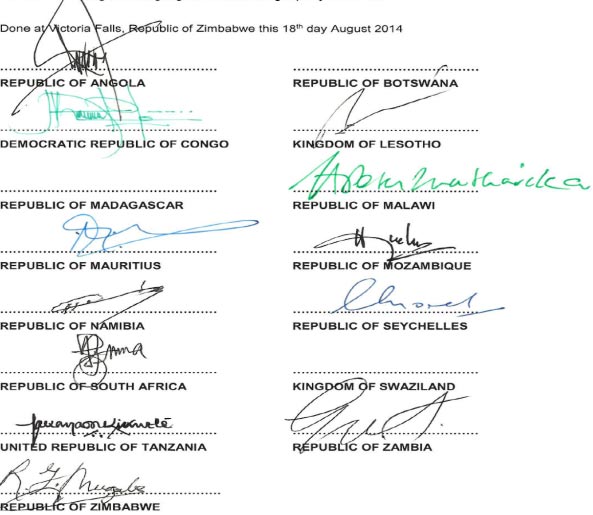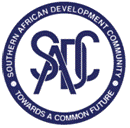SOUTHERN AFRICAN DEVELOPMENT COMMUNITY (SADC)
DECLARATION ON REGIONAL INFRASTRUCTURE DEVELOPMENT
We, the Heads of State or Government of:
The Republic of Angola;
The Republic of Botswana;
The Democratic Republic of Congo;
The Kingdom of Lesotho;
The Republic of Madagascar;
The Republic of Malawi;
The Republic of Mauritius;
The Republic of Mozambique;
The Republic of Namibia;
The Republic of Seychelles;
The Republic of South Africa;
The Kingdom of Swaziland;
The United Republic of Tanzania;
The Republic of Zambia;
The Republic of Zimbabwe;
RECALLING the vision mission objectives and principles of the Southern African Development Community (SADC) and in particular Article 21 (areas of cooperation) of the SADC Treaty as amended;
FURTHER RECALLING the broad vision of the Abuja Treaty of June 3rd, 1991 in establishing the African Economic Community, as well as the broader objectives of the Constitutive Act of the African Union concluded at Lome, Togo on the 11th July 2000 to accelerate the economic integration of the continent, with the aim of achieving sustainable development and economic growth, as well as the reduction of poverty;
NOTING the initiatives on the development of infrastructure in Africa, in particular the Programme for Infrastructure Development in Africa (PIDA), the New Partnership for Africa’s Development (NEPD) through its Infrastructure Project Preparation Facility, the Heads of State and Government Orientation Committee (HSGOC), and the Presidential Infrastructure Championing Initiative (PICI) aimed at accelerating continental infrastructure projects identified by the PIDA; the Infrastructure Consortium for Africa (ICA) which was launched at the G8 Gleneagles (Scotland, United Kingdom) in 2005; and the Africa – European Union Infrastructure and Energy Partnership contained in the New European Union Strategy for Africa adopted in December 2006 and confirmed by the African Union Summit in January 2007;
ALSO TAKING NOTE of the importance placed on improved African infrastructure by the G8 Summit meeting in June 2013 in Northern Ireland in the United Kingdom, in particular its commitment to provide increased support for project preparation facilities for African regional programmes and its recognition of the importance of the NEPAD Infrastructure Project Preparation Facility hosted by the African Development Bank (AfDB);
ALSO RECALLING the stated aims of the Tripartite arrangement between the Common Market for East and Southern Africa (COMESA), the East African Community (EAC) and SADC as outlined in the Memorandum of Understanding on Inter Regional Cooperation and Integration signed between the Parties for joint implementation of the inter-regional infrastructure programmes, as well as institutional arrangement;
RECOGNISING that infrastructure development, together with market integration and industrial development form three key pillars for sustainable development within the three regional economic communities (COMESA, EAC and SADC) negotiating a Tripartite Free Trade Area and that the development of infrastructure can attract investment into and within the Region and catalyse industrial development;
DERTEMINED to boost intra-Africa trade through addressing regulatory and infrastructure constraints;
ALSO RECOGNISING the critical role that infrastructure can play in the speedy integration of the Region particularly through the ease of movement of goods, services, capital and people.
CONCERNED that without adequate and robust infrastructure it would be extremely difficult to achieve accelerated and sustainable development in backbone sectors and noting that this is the single largest obstacle to doing business in the Region;
ALSO CONCERNED by the high costs of infrastructure in the Region resulting in such infrastructure being inaccessible to, and unaffordable by a majority of our populations, and that this also results in increased production and transaction costs, reduced competitiveness of business, and also negatively impacts on intra-regional and foreign direct inflows,
DETERMINED to accord high priority to infrastructure development in the Region, its construction, expansion, integration, rehabilitation improved maintenance and enhanced operation and management;
COGNISANT of the undertaking of the United Nations (A/RES/55/2) of 18 September 2000 to address the special needs and problems of landlocked developing countries concerning the impediments of geography by improving their transit transport systems;
ALSO COGNISANT of the need to grant special treatment to Member States classified as least developed countries and adoption of special measures in favour of landlocked, semi-landlocked and small island developing states; and
AIMING at increasing efforts to implement the SADC Regional Infrastructure Development Master Plan (RIDMP).
HAVE AGREED TO USE OUR BEST EFFORTS TO:
1 promote mutually cooperation between Member States in the rapid development of bankable projects that will foster adequate and efficient trade routes for regional and international trade and develop robust infrastructure in energy, transport, ICT, water, meteorology and tourism;
2 identify joint initiatives for the development, management and operationalization of regional infrastructure and strengthen regional institutions with adequate capacities;
3 encourage local and regional content in the implementation of projects so as to leverage the infrastructure work programme to catalyse industrial development;
4 deepen regional integration and achieve sustained development so as to ensure peace and security, economic and social progress, the development of infrastructure should be the bedrock of our building efforts;
5 engage in a collective effort to deal with the current global economic and financial challenges in order to open up opportunities for strong and balanced growth in the future;
6 implement regional agreements and protocols to facilitate development of infrastructure that promotes industrial development and creation of regional value chains and in order to achieve sustainable growth and development;
7 collaborate with the AfDB, international cooperating partners, private sector and other stakeholders to secure funding for infrastructure development in SADC, particularly for project preparation, in order to attract investment, promote industrialisation, as well as fully realise optimal returns from the abundant natural resources in the region;
8 identify innovative solutions to deal with the infrastructure deficit in the Region, and to this end embrace advanced technologies through more efficient decision-making processes, greater coherence, close coordination and bolder action in different sectors;
9 cooperate with and provide space for the private sector to invest in bankable projects for durable infrastructure development particularly through Public Private Partnerships to achieve balanced development, in the region in order to boost economic growth and job creation, giving particular attention to the development of youth entrepreneurship and micro, small and medium enterprises;
10 facilitate the implementation of all necessary legal, institutional, fiscal, policy, procedural and regulatory measures to create an environment in which the private sector can play a meaningful role in infrastructure development, construction, expansion, maintenance, rehabilitation and operation;
11 achieve resilience against the impact of climate change by preparing and implementing national and regional adaptation and mitigation plans in order to prolong the life of infrastructure;
12 improve our infrastructure project identification, design, planning, preparation, and project execution through enhanced coordination, governance and institutional structures, as well as optimum deployment of resources to avoid non-productive expenditure;
13 fully support the Programme for Infrastructure Development in Africa (PIDA) and the Presidential Infrastructure Championing Initiative (PICI);
14 engage our populations in labour intensive projects for the construction, expansion, rehabilitation and maintenance of appropriate levels of infrastructure in order to address issues of poverty alleviation and its ultimate eradication and to engender citizenship and ownership;
15 pay particular attention to the transport needs of landlocked Member States which due to their geo-political circumstances have special needs for transport and transit services and bear associated high costs for capacity and access to external markets and in this regard to fully implement the goals of the UN Almaty Declaration of August 2003 (A/CONF.202/3) and the Almaty Programme of Action (A/CONF.202/3) (Annex I) in our Region;
16 engage relevant stakeholders to ensure equitable access to international and regional broadband infrastructure, including undersea cable networks at fair and affordable costs, and that this should apply especially to landlocked and island Member States for the provision of universal broadband services and improving SADC’s competitiveness;
17 fully implement the RIDMP within its defined implementation plan and to make concerted efforts to bring all the projects identified in the RIDMP to bankability stage and secure funding for them in order to support our efforts to modernise and diversify our economies;
18 enhance efforts at finalising the operationalization of the SADC Regional Development Fund (in accordance with article 26A of the SADC Treaty and the implementation of the SADC Project Preparation Development Facility)
19 mandate the SADC Ministers responsible for infrastructure to prioritise the implementation of this Declaration and monitor its progress accordingly in order to achieve its intended objectives;
20 encourage all stakeholders, including all Regional Finance Institutions and the private sector, to provide all necessary support for the implementation of this Declaration and the RIDMP; and;
21 review progress on the implementation of this Declaration on a regular basis during Summit meetings
IN WITNESS WHEREOF, we, the undersigned, being duly authorised representatives of our respective Governments, have signed this Declaration in three (3) original texts, in the English, French and Portuguese languages, all texts being equally authentic.

